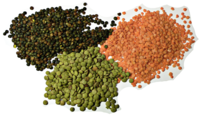
Photo from wikipedia
Salt stress greatly disturbs the growth, morpho-physiological, and biochemical performance of plants. However, different physiological processes and acclimation mechanisms can be induced under stress, while some of them can be… Click to show full abstract
Salt stress greatly disturbs the growth, morpho-physiological, and biochemical performance of plants. However, different physiological processes and acclimation mechanisms can be induced under stress, while some of them can be modulated by the appropriate chemical stimulus. The objective of this study was to evaluate the impact of exogenous pretreatment with 10 mM l-glutamic acid (l-Glu) on the physiological and biochemical parameters of lentil (Lens culinaris Medik.) under 110 mM NaCl stress. Salt stress inhibited the growth and reduced the photosynthetic pigment (chlorophylls and carotenoids) level, water content, and survival of lentil seedlings during recovery from the stress. Salt stress also induced oxidative damage, as indicated by higher hydrogen peroxide and malonaldehyde contents and electrolyte leakage, by interrupting the antioxidant defense system and promoting the accumulation of toxic levels of Na+. However, l-Glu pretreatment mitigated the salt-induced damage in lentil seedlings by reducing the accumulation of Na+, maintaining ion homeostasis, and increasing the activities of antioxidant enzymes (catalase and ascorbate peroxidase). As a result, salt-induced oxidative damage was reduced, seedling growth and photosynthetic pigment contents were enhanced, and the survival rate of the lentil seedlings was improved in response to salt stress, indicating an ameliorative role for l-Glu in lentil seedling growth under salt stress.
Journal Title: Biomolecules
Year Published: 2021
Link to full text (if available)
Share on Social Media: Sign Up to like & get
recommendations!